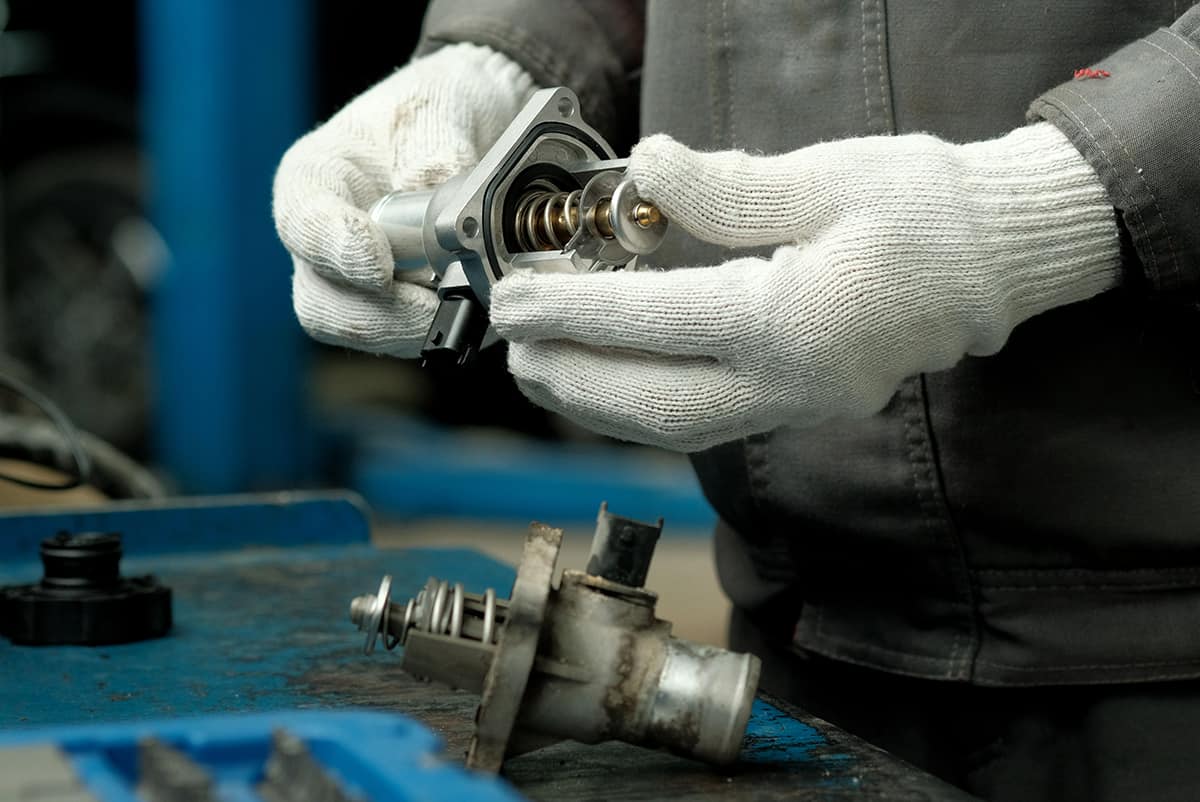The thermostat is a critical component of your car’s cooling system. Its primary function is to regulate the flow of coolant to the engine, ensuring optimal operating temperature.
A well-functioning thermostat is essential for maintaining the health of your engine and by extension, the overall performance of your vehicle. However, like any other part of a car, thermostats can develop faults over time. Recognizing the symptoms of a faulty thermostat can prevent serious engine damage and costly repairs.
Common symptoms of a faulty car thermostat to look for are as follows:
- Overheating engine
- Engine staying cold for too long
- Fluctuating engine temperature
- Decreased fuel efficiency
- Coolant leaks
This article will guide you through a comprehensive understanding of car thermostat symptoms. We will learn the basics of how a thermostat works, detailed symptoms, the effects of a faulty thermostat, and how to address the problem.
Basics of Car Thermostats

A car’s thermostat operates based on the temperature of the coolant. When the engine is cold, the thermostat remains closed, preventing coolant from circulating. This allows the engine to warm up quickly to its optimal operating temperature. Once the engine heats up, the thermostat opens to allow coolant to circulate, preventing the engine from overheating.
The thermostat achieves this using a simple but effective mechanism. Inside the thermostat is a wax pellet that melts and expands when heated. As your engine warms up, the heat causes the wax pellet inside the thermostat to expand. This expansion pushes against a rod that opens the valve, allowing coolant to flow.
There are two main types of thermostats used in vehicles: wax pellet thermostats and bellows thermostats.
- Wax Pellet Thermostats: This is the most common type of thermostat found in modern vehicles. The operating principle of a wax pellet thermostat is as explained earlier. The wax inside the thermostat melts and expands when heated, pushing a rod to open the valve. This allows coolant to flow through the system.
- Bellows Thermostats: Bellows thermostats operate a bit differently than wax pellet thermostats. They use a series of metallic bellows filled with a volatile, heat-reactive liquid. When heated, this liquid vaporizes, causing the bellows to expand and open the valve. Though not as common in modern vehicles, bellows thermostats are still found in some older or classic cars.
Detailed Symptoms of a Bad Car Thermostat
A malfunctioning car thermostat can present several symptoms. Let’s dive into these symptoms in detail.
1. High Temperature Readings
When your car’s thermostat is stuck closed, coolant can’t circulate through the engine. The trapped heat increases engine temperature, reflected as a high reading on your temperature gauge. If your vehicle’s temperature gauge indicates overheating shortly after you start the engine, it’s a strong sign of a bad thermostat.
2. Low-Temperature Readings
A thermostat stuck in the open position will allow continuous coolant flow, even when the engine is not sufficiently heated. This situation results in the engine taking a longer time to reach its optimal operating temperature, or it might not reach it at all. Low-temperature readings, particularly in cold weather, could indicate a faulty thermostat.
3. Inconsistent Temperature Changes
Inconsistent or erratic temperature readings can signal a failing thermostat. If your temperature gauge fluctuates between hot and cold, it could mean the thermostat is opening and closing irregularly. This inconsistent operation disrupts the balance of coolant circulation, leading to unstable engine temperatures.
4. Poor Fuel Efficiency
Fuel efficiency and engine temperature are directly related. If the engine operates below its ideal temperature (thermostat stuck open), it can lead to incomplete fuel combustion.
Conversely, an overheating engine (thermostat stuck closed) can cause the engine to work harder, leading to higher fuel consumption. If you notice a decrease in your vehicle’s fuel efficiency, it might be due to a malfunctioning thermostat.
5. Visible Coolant Leaks
A damaged thermostat housing or seal can cause coolant leaks. You may notice a puddle of coolant under your vehicle or a low coolant level in the reservoir. While leaks can arise from multiple sources, a leaking thermostat housing is a definite sign of a faulty thermostat.
Responding to Car Thermostat Symptoms

Responding appropriately and promptly to car thermostat symptoms can prevent serious engine damage and help maintain your vehicle’s performance. Here are some steps to take when you identify potential thermostat issues.
1. Inspect Your Thermostat
If you suspect a faulty thermostat, the first step is to inspect it. However, do this only when the engine is cold to prevent burns from hot coolant or steam. Look for visible signs of damage, such as corrosion, a broken frame, or a stuck valve. A malfunctioning thermostat often gets stuck in either an open or closed position.
2. Monitor Your Temperature Gauge
Your temperature gauge can provide valuable insights into the state of your thermostat. A gauge that quickly rises to high temperatures or doesn’t move up from a cold reading may indicate a stuck thermostat. On the other hand, if the gauge fluctuates between high and low temperatures, it may signal an inconsistent thermostat.
3. Check for Coolant Leaks
A coolant leak near the thermostat housing could indicate a broken seal or a cracked housing—both signs of a faulty thermostat. Regularly check under your vehicle for puddles of coolant, which usually has a bright green or orange color and a sweet smell. Also, check your coolant reservoir level frequently and top it up as needed.
4. Thermostat Replacement
If your thermostat is faulty, the solution is usually to replace it. Replacing a car thermostat is a delicate process and often involves draining the coolant, removing the thermostat housing, replacing the thermostat, and then refilling the coolant. While it’s possible to do this yourself if you have mechanical experience, it’s often best left to professionals to avoid complications.
5. Seek Professional Help
If your DIY checks confirm thermostat problems or if you’re unsure about the diagnosis, it’s time to seek professional help. A certified mechanic can perform a comprehensive inspection and accurate diagnostics to confirm whether the thermostat is the issue.
FAQs
1. How do I know if my car thermostat is stuck open or closed?
Determining whether your car thermostat is stuck open or closed depends on your engine’s behavior and temperature readings. If it’s stuck closed, coolant cannot circulate, causing the engine to overheat quickly—you’ll notice this on your temperature gauge.
On the other hand, if it’s stuck open, the coolant continuously flows, preventing the engine from reaching its optimal operating temperature. You’ll observe this as a lower-than-normal temperature reading, particularly during cold weather.
2. How much does it cost to replace a car thermostat?
The cost to replace a car thermostat can vary widely, depending on the make and model of your vehicle and the pricing of your mechanic or auto repair shop. On average, you can expect the cost for parts and labor to range between $150 and $200.
However, in some luxury or high-performance vehicles, this cost could be higher. It’s always a good idea to get a quote from a reliable auto repair service before proceeding with the replacement.
3. How long does a car thermostat last?
A car thermostat doesn’t have a specific lifespan and can last anywhere from 10 to 20 years or more. However, numerous factors can affect its longevity, including driving habits, the type of vehicle, and how well the vehicle’s cooling system is maintained.
Regular maintenance, such as proper coolant levels and timely coolant changes, can extend a thermostat’s life. However, if you notice signs of a faulty thermostat, it’s recommended to replace it to avoid potential engine damage.






